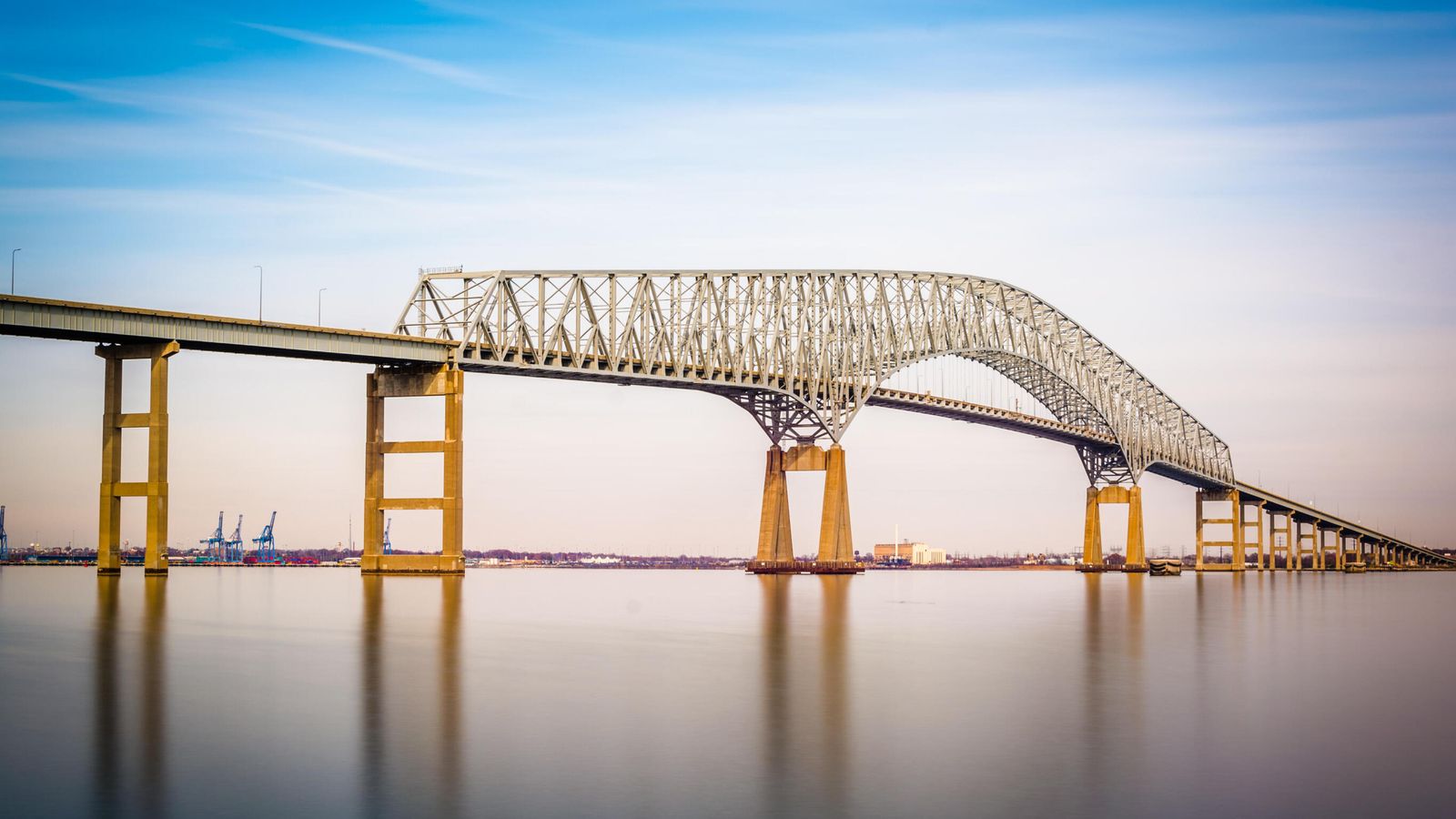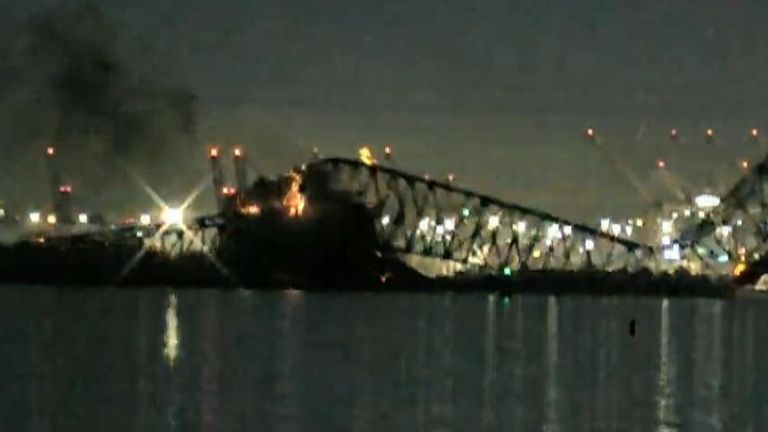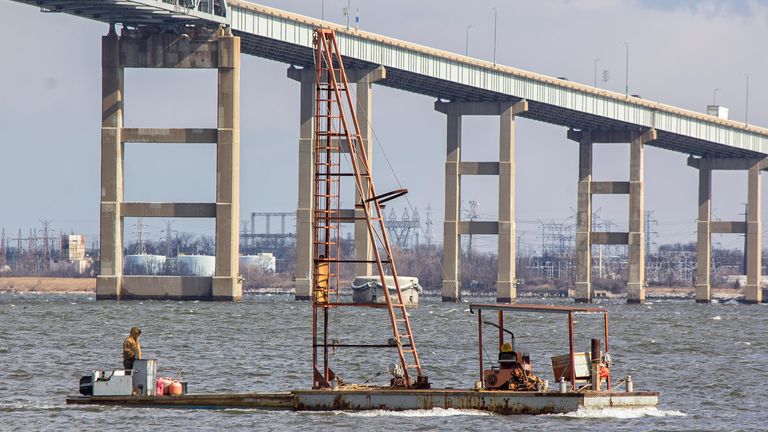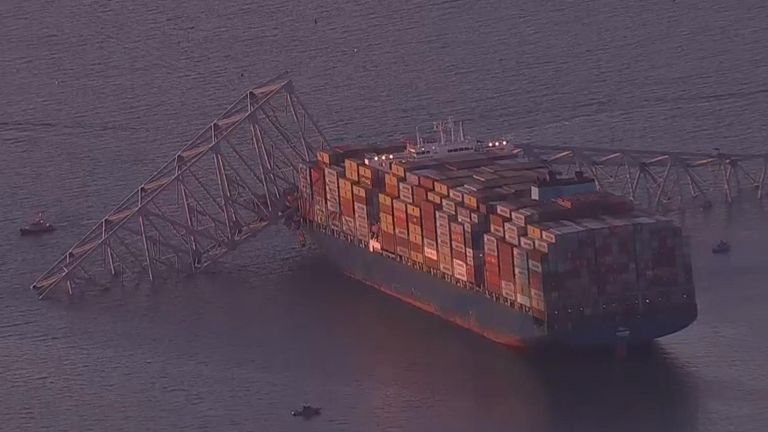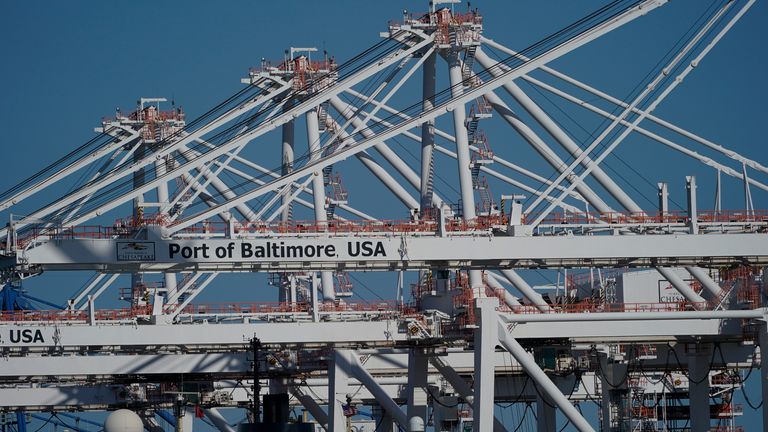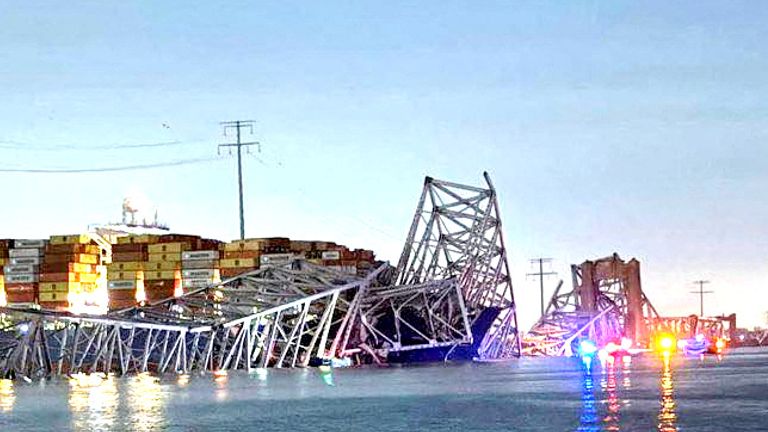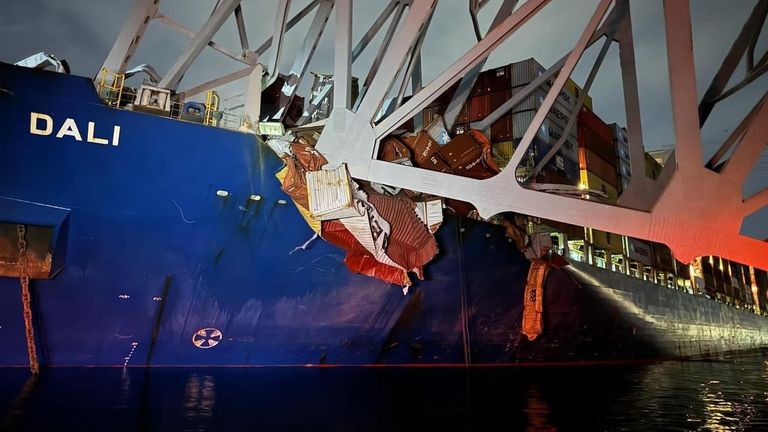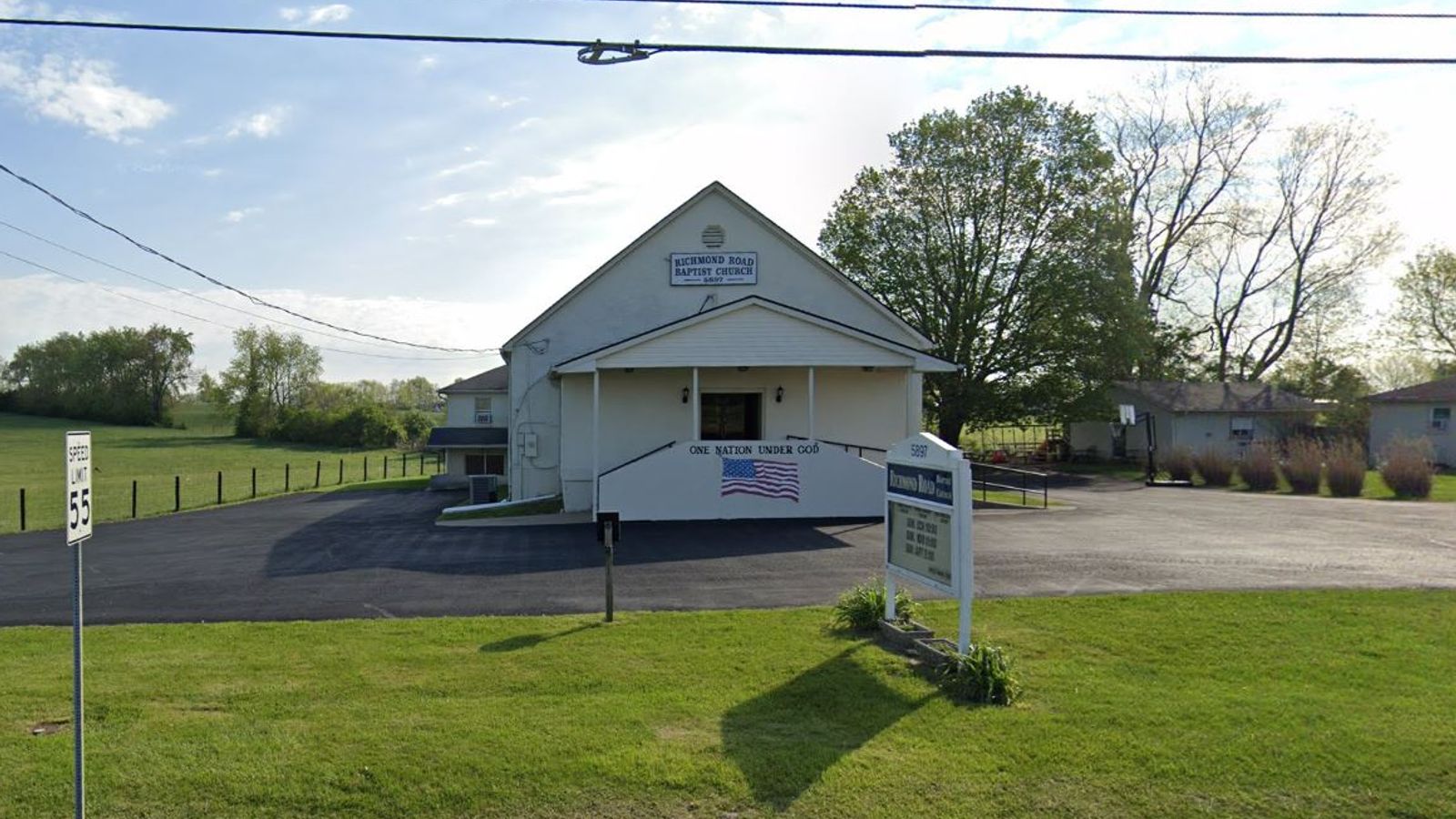
A major bridge has collapsed in the US city of Baltimore after it was hit by a cargo ship in what the city’s fire department has called a “dire emergency”.
Rescue teams are searching the water by the fallen Francis Scott Key Bridge for casualties, with eight people thought to have fallen in, according to the Baltimore City Fire Department (BCFD).
Two people have been rescued from the water and one is in a “very serious condition”, said BCFD chief James Wallace.
Emergency responders are still searching for six people in the water who are believed to be part of a construction crew that was repairing potholes on the bridge, the Maryland Department of Transportation has said.
Here’s everything we know about the incident so far.
What happened?
A large section of the 1.6 mile-long bridge fell into the water following the collision at around 1.30am local time (5.30am UK time).
The city fire department’s communications chief Kevin Cartwright has called the incident a “developing mass casualty event”, adding it was too early to know how many people were affected.
What does the video show?
It shows the vessel approaching the bridge before the structure collapses into the water.
Vehicles can be seen falling from the bridge.
Search of the water ongoing after two people rescued
Emergency services searching the water rescued two people this morning, one of whom has been transferred to a local trauma centre in a “very serious condition”, BCFD chief James Wallace said.
The other person, he added refused care and was not injured.
Baltimore bridge latest:
Ship ‘lost power’ before crash; ‘at least seven people’ still in water – follow live updates
What caused the collision?
Emergency teams may be looking for “upwards of seven individuals”, he said. When asked about why the department’s spokesperson had earlier suggested as many of 20 workers could have fallen in, he noted it was a “very large incident” with a “very large footprint”.
“Information is subject to change as we get more intel,” he added.
Mr Wallace said the “challenging” rescue operation was being guided by dive teams, and added: “We’re battling darkness. It’s quite possible we may have somebody there that we’ve not seen yet.”
He said experts will advise on when the “non-survivability point” has been reached.
The BCFD’s chief spokesperson earlier warned: “This operation is going to extend for many days.”
Cars fell into the river
Mr Cartwright said multiple vehicles were on the Key Bridge when it was struck by the ship, one of which was the size of a tractor-trailer.
He said it appears there are “some cargo or retainers hanging from the bridge”, creating unsafe and unstable conditions, and that emergency service workers were operating cautiously as a result.
Reports all lanes were closed before bridge collapse
There were early reports that all lanes on the bridge were closed before the collapse and all traffic was already being re-routed.
The Maryland Transport Authority confirmed the closure on social media just before 2am, saying “all lanes closed in both directions for incident on I-695 Key Bridge” – but did not say whether they were closed before or after the collision.
It has since been confirmed by Maryland governor Wes Moore that operators of the ship issued a mayday call moments before slamming into the bridge.
Mr Moore said the boat was travelling at a speed of eight knots so there was limited time, but that those who received the distress call prevented vehicles from coming onto the bridge.
“Those people are heroes, they saved lives,” he said.
What do we know about the bridge itself?
The Francis Scott Key Bridge is an enormous steel structure which carries the Interstate 695 highway over the Patapsco River southeast of the Baltimore metropolitan area.
Built in 1977 and referred to locally as the Key Bridge, it was named after the author of the American national anthem.
The bridge is more than 8,500ft, or 1.2 miles, long in total.
Its main section spans 1,200ft and was one of the longest continuous truss bridges in the world upon its completion, according to the National Steel Bridge Alliance.
What do we know about the ship that hit it?
The container ship, known as Dali, was headed to Colombo in Sri Lanka at the time of the collision.
It appears to have sustained damage, a fire department official told Sky News partner network CNBC, though the ship’s management company Synergy Marine Group said all 22 crew members on board have been accounted for and no injuries have been reported.
It confirmed the Singapore-flagged Dali vessel collided with one of the Key Bridge pillars while under the control of two pilots. The firm said the exact cause of the incident was yet to be determined.
The whole crew is still on board the vessel but are communicating with the coastguard.
ABC News has now reported the crew have told officials the ship had “lost propulsion” as it was leaving the port.
ABC quoted an unclassified US intelligence report by the Cybersecurity and Infrastructure Security Agency as saying: “The vessel notified MD Department of Transportation (MDOT) that they had lost control of the vessel and an collision with the bridge was possible. The vessel struck the bridge causing a complete collapse.”
CCTV and marine tracking data shows the container ship lost power for around 60 seconds about four minutes before it hit the bridge. It appeared to adjust its course and start smoking before impact.
The vessel’s individual incident response service has been mobilised, Synergy added.
According to ship tracking website VesselFinder, Dali had been involved in a 2016 collision at the Port of Antwerp as it tried to leave the port.
It said the vessel had “substantial stern momentum” causing the collision with a stone wall of the quay.
The berth where the ship had been docked was “seriously damaged and closed for cargo handling operations due to safety reasons”, the website said.
About the Port of Baltimore
The harbour is the deepest in Maryland’s Chesapeake Bay – the largest estuary in the US. It has five public and 12 private terminals and is one of the busiest ports in the US.
It’s the most active US port for car shipments, handling more than 750,000 vehicles in 2023, according to data from the Maryland Port Administration.
And it’s the largest US port by volume for handling farm and construction machinery, as well as agricultural products. Last year its agricultural imports totalled three million tonnes, including 1.2 million tonnes of sugar and salt, according to data analysts Kpler.
More than 40 ships remained inside the port after the incident, data from MarineTraffic shows, including small cargo ships, tug boats and pleasure craft.
It was not immediately clear if any other vessels had been damaged or whether operations had halted to and from the port, shipping and insurance sources told Reuters.
We do know it’s closed to traffic after the incident until further notice.
What have experts said?
A maritime safety expert says the “most likely” cause of the crash was a failure in the ship’s machinery.
David McFarlane, director of Maritime Risk and Safety Consultants Ltd, told Sky News: “The first thing that springs to my mind is: was there a sudden fault with the ship’s engines or the steering gear? The other, of course, is: was there a navigational error?”
Mr McFarlane said a human error was less likely because of the number of people who would have been on duty.
He added: “There should be no room for one-person errors because one of the other people should jump in and say ‘hang on…’.
“The most likely cause of this is a failure in machinery or steering gear, but we just won’t know until the authorities have been on board. And even then, they’re unlikely to say what’s been going on for some considerable time.”
Lead up to incident seemed ‘unusual’
“It’s a frightful incident and shows how fragile maritime infrastructure is if you don’t get things right,” said Chris Parry, former Royal Navy rear admiral.
“It’s happening at night… so mercifully, there won’t be too many people on the bridge. It’s not commuter time.”
He said it appears from video footage that the ship was “off track” as it headed towards the bridge, adding: “Normally the air traffic control system would have warned him [the pilot] about that if he was on track for the bridge.
“Frankly it’s a routine operation,” he continued. “We’re going to have to wait for the inquiry to see what happened. But it’s unusual unless they’ve had a mechanical or electrical failure that that sort of thing should happen.”
Is it normal for a bridge to collapse so suddenly?
Civil and structural engineer Julian Carter told Sky News bridges such as the one in Baltimore are “very weak at points”.
“It proves with many of these structures – and we have similar ones in the UK – that they’re actually quite simple in concept… but they’re very weak at certain points. And a ship collision is quite complex because as a ship impacts, it changes shape.
“But you can imagine the amount of energy that is in that container ship, thousands and thousands and tons that are coming to hit the pier.
“Now they’ve hit the pier, and that certainly would not have been part of the design basis, I would assume, otherwise we’d have very large fenders around that pier base as it’s in the water,” Mr Carter continued.
“An incredibly unfortunate event that with modern technology [like] satellite navigation, we would expect it just simply not to happen.
“But if you then look at the way that it has collapsed, it’s what we call a continuous structure – every little piece is connected to another. And unfortunately, it’s catastrophic collapse.”
Barbara Rossi, associate professor of engineering science at the University of Oxford, said: “The bridge has received a huge impact force on one of its supporting structure. The supporting structure appears to be made of reinforced concrete.”
Professor Rossi added the force impact “must have been immense to lead these massive concrete structures to collapse, leaving the superstructure without one of its supports”.
She added the video footage shows that once the arch collapses, “the entire structure loses its stability”.
How much could reconstruction cost?
A civil engineering specialist has suggested it could cost as much as $600m (£474m).
David Mackenzie, chair of engineering and architecture consultancy COWIfonden, told Sky News constructing the bridge in the 1970s cost roughly $60m.
“It’s going to be over 10 times that to rebuild it at least,” he said.
The pressure on commuter traffic means it will have to be carried out quickly he added, with the procurement process “short cut hugely”.
“It is going to be an expensive rebuild,” he said.
Mr Mackenzie said it will also require a “complete redesign” with enhanced ship impact protection.

